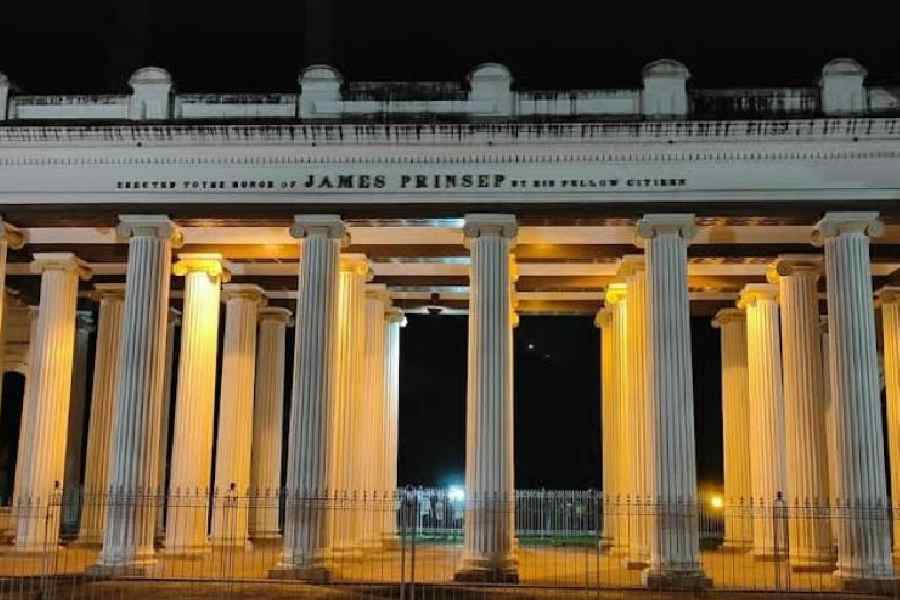Prinsep Ghat, a Palladian porch on the east bank of the Hooghly erected to commemorate the English polymath James Prinsep, served as the gateway to the city from the time it was constructed in 1843 till about the 1920s.
Visitors alighting at the ghat would be greeted by two Chunar stone couchant lions commissioned by Prinsep’s brother William, in memory of the scholar. However, today, there are no signs of the lions at the ghat or the porch. These lions have faded from public memory now. Ever since the construction of Vidyasagar Setu began, the lions were summarily lifted and planted inside Fort William as the area was cordoned off forconstruction.
Writes Anant Sinha in an article titled “James Prinsep’s Lions”, in a commemorative issue of Journal of the Asiatic Society on the 225th birth anniversary of James Prinsep, “It is interesting to note that James Prinsep was the decipherer of the earliest historical scripts of India, appearing on the inscriptions of Asoka, whose royal emblem was, inter alia, couchant lions.Did William wish to honour his deceased brother with the most vibrant emblem of Asoka?”
Rajat Sanyal, the editor of the special issue on Prinsep, added his analysis. “It is interesting to note that while symmetry was the norm of the statuaries during those times, the two lions had a dissimilarity. While one was a couchant, another was a slumbering lion,” he pointed out.
According to him, while the couchant lion represented Prinsep as a lion in the various disciplines he dabbled in, the slumbering lion probably represented him in his death.
Sinha writes that a James Prinsep Testimonial Committee was constituted and headed by Sir Edward Ryan after the premature death of James Prinsep in 1840. The committee decided to construct a ghat on the bank of the river Hooghly, the design of the ghat was proposed by Robert Halden Rattray, a judge and friend of James Prinsep.
The construction work was awarded to Burn & Co. They submitted an estimate of ₹26,000, of which citizens raised ₹12,000 and the balance was donated by the governor from the Public Treasury.
The ghat, designed by W. Fitzgerald, was erected in 1843. The site between George Gate and the Water Gate of Fort William was chosen. The superstructure of the ghat was constructed on neoclassical architectural principles along with the steps leading to the river with two couchant lions standing guard at the head of the stairs leading to the river. Now the commemorative monument and the Prinsep Ghat are separated by about 100 metres because of changes in the landscape of the river.
In 1993, INTACH restored Prinsep Ghat.
Such nuggets of information on James Prinsep, including his set of paintings of the city of Banaras, have been published in a special issue of the Journal of the Asiatic Society dedicated to the Orientalist, antiquarian, numismatist, painter, chemist, architect James Prinsep on his 225th birth anniversary.
This issue dwells on his multifarious research and publications.
James Prinsep (1799-1840) was 15 years younger than the Asiatic Society, founded in 1784, said the administrator of Asiatic Society, Anant Sinha. In fact, Prinsep was the founder editor of the Journal of the Asiatic Society of Bengal (JASB) that started in 1833, as the descent of its predecessors, the Asiatick Researches and Gleanings in Science.
Of his 19 years of service in India, Prinsep spent more time in Banaras than Calcutta, says Sanyal. In both cities, he was the assay master of the mints and proposed a uniform currency in British India and also invented measuring instruments that were precise enough to measure one-thousandth part of a metal.
Painting was a family trait and his siblings William and Emily were talented painters. Prinsep started drawing Banaras right from the time he journeyed to Banaras from Calcutta .
“He wrote to his father that ‘I am sitting in Banaras in the cold and I didn’t waste time, I made a map of Banaras.’ Prinsep’s paintings are an unparalleled representation of Banaras in the early nineteenth century. It came from a desire to represent newly acquired territory, particularly the landscape representation that was a visually striking element to them,” said Sanyal.
The special issue contains chapters by various scholars that reassess Prinsep and his works and value his relevance today.

